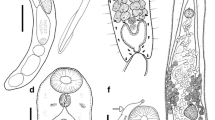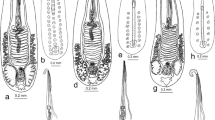Summary
The life0cycle of the digenetic trematodeHolorchis pycnoporus M. Stossich, 1901 is described. The redial stages (first generation redia and daughter rediae) occur throughout the genital gland ofBarleeia rubra (Adams) a marine Prosobranch (Rissoidea). When cercariae leave rediae, they are not fully developed; the development is completed outside redia, within snail tissues, among rediae. Cercariae belong to the ophthalmotrichocercous group. Some cercariae encyst in situ, within genital gland tissues of the first intermediate host. Thus,B. rubra acts as first and second intermediate host. Almost all cercariae leave the molluscan host and are free swimming larvae; they penetrate the second host,Parvicardium papillosum (Bivalvia, Cardiidae) and develop into encysted metacercariae. Experimental development of metacercariae into adults have been obtained inDiplodus sargus andD. annularis (Teleostei, Sparidae). The habitat where the cycle is involved is described. The generic diagnosis ofHolorchis is emended; the place of this genus in Lepocreadiidae W. Nicoll, 1935 is discussed.
Résumé
Les auteurs décrivent en détail les différents stades du cycle biologique du générotypeHolorchis pycnoporus M. Stossich, 1901. Les rédies de première générotions parasitent la glande génitale deBarleeia rubra (Adams) (Prosobranche marin, Rissoidea). Les cercaires, du type ophtalmotrichocerque, sont pondues tôt et mûrissent en dehors des rédies filles. Quelques cercaires s'enkystent sur place, dans la gonade du premier hôte.B. rubra joue donc à la fois le rôle de premier et de deuxième hôte. La majorité des cercaires est libérée dans le milieu extérieur. Les cercaires s'enkystent dansParvicardium papillosum (Poli) (Lamellibranche, Cardiidae). Les vers adultes ont été obtenus expérimentalement chezDiplodus sargus etD. annularis (Téléostéens, Sparidae). Le milieu dans lequel se déroule le cycle biologique est précisé. La diagnose du genreHolorchis est émendée et sa place dans la famille des Lepocreadiidae W. Nicoll, 1935 est discutée.
Similar content being viewed by others
Références
Brinkmann, Jr., A.: Some trematodes from marine fishes in the waters of Rhodes. Årb. Univ. Bergen, Mat.-Nat. Serie10, 1–13 (1966)
Cable, R.M., Hunninen, A.V.: Studies onDeropristis inflata (Molin), its life history and affinities to trematodes of the family Acanthocolpidae. Biol. Bull.82, 292–312 (1942)
Dollfus, R.Ph.: Sur un distome parasite deMullus surmuletus L. et peut-être attribuable au genreHolorchis M. Stossich, 1900 (Trematoda). Bull. Inst. Océanogr. Monaco43, 1–7 (1946)
Dollfus, R.Ph.: L'ênigme deDistoma furcatum Bremser enfin expliquée. Contribution à la connaissance des Trématodes des Poissons du genreMullus en Méditerranée. Bull. Inst. Océanogr. Monaco45, 1–23 (1948)
Durio, W.O., Manter, H.W.: Some digenetic trematodes of marine fishes of New Caledonia. Part II. Opecoelidae and Lepocreadiidae. J. Parasitol.54, 747–756 (1968)
Fischthal, J.H., Kuntz, R.E.: Digenetic trematodes of fishes from Palawan Island, Philippines, Part III. Families Hemiuridae and Lepocreadiidae. Proc. Helminthol. Soc. Wash.31, 109–120 (1964)
Manter, H.W.: Some digenetic trematodes from fishes of New-Zealand. Trans. R. Soc. New Zealand82, 475–568 (1954)
Orecchia, P., Paggi, L.: Su due specie del genereHolorchis Stossich, 1901 parassite dell'intestino diPagellus erythrinus: Holorchis micracanthum (Stossich, 1888) comb. n. (sinonimoDistomum micracanthum Stossich, 1888) eHolorchis pycnoporus Stossich, 1901. Segnalazione nuova. Parassitologia.16, 215–223 (1974)
Paggi, L., Orecchia, P.: Ridescrizione diHolorchis pycnoporus Stossich, 1901 parassita dell'intestino diDiplodus vulgaris (Geoffroy Saint-Hilaire) 1809e considerazioni sul genereHolorchis Stossich, 1901. Parassitologia16, 209–214 (1974)
Skrjabin, K.I., Koval, V.P.: Keys to the trematodes of animals and man. In: K.I. Skrjabin et al. Urbana: University of Illinois Press 1964
Stossich, M.: Osservazioni elmintologiche. Boll. Soc. Adr. Sc. nat. Trieste20, 89–103 (1901)
Thomas, J.D.: Trematodes of Ghanaian sub-littoral fishes. II. The family Lepocreaiidae Nicoll, 1935, sensu Cable and Hunninnen, 1942. Lib. Hom. Dr. Ed. Caballero y Caballero, 321–328 (1960)
Yamaguti, S.: Systema helminthum. Vol. I. The digenetic trematodes of vertebrates. Part. I and II. New York, London: Interscience Publishers 1958
Yamaguti, S.: Synopsis of digenetic trematodes of vertebrates. Vol. I and II. Keigaku 1971
Author information
Authors and Affiliations
Rights and permissions
About this article
Cite this article
Bartoli, P., Prévôt, G. Le cycle biologique deHolorchis pycnoporus M. Stossich, 1901 (Trematoda, Lepocreadiidae). Z. Parasitenkd. 58, 73–90 (1978). https://doi.org/10.1007/BF00930794
Received:
Issue Date:
DOI: https://doi.org/10.1007/BF00930794




